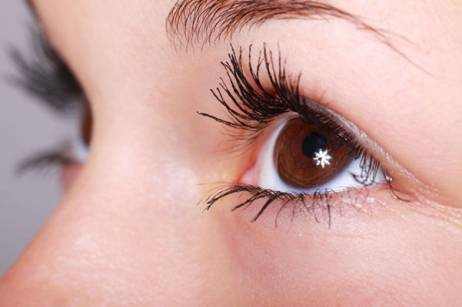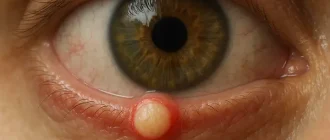Astigmatism is a refractive error, meaning it’s not an eye disease or a health issue but rather a problem with how the eye focuses light. In a healthy eye, light focuses sharply on the retina. In an eye with astigmatism, the cornea or lens has an irregular shape, causing light to scatter and focus at multiple points, either in front of or behind the retina. This leads to blurred or distorted vision at all distances.
Prevalence of Astigmatism by Age Group
Symptoms of Astigmatism
The primary symptom of astigmatism is blurry or distorted vision. Other common symptoms include:
- Eye strain or that uncomfortable feeling you get after binging your favorite shows or tackling a long workday on the computer.
- Nagging headaches that just won’t quit, especially after a lot of reading or screen time.
- Squinting—you know, that thing you do to make the world look sharper.
- Struggling to see clearly in dim light or at night, like when you’re driving or trying to read street signs.
Case Spotlight: John’s Struggle with Blurred Vision
John, a 34-year-old software engineer from California, noticed persistent headaches and blurry vision after long hours at his desk. A routine eye exam revealed moderate astigmatism, which was corrected with toric contact lenses, drastically improving his work performance and reducing discomfort.
Causes and Risk Factors
Astigmatism is usually caused by an irregularly shaped cornea. Instead of being perfectly round like a basketball, the cornea might resemble a football, with one meridian more curved than the other. This uneven curvature distorts the path of light entering the eye.
Other contributing factors include:
- Lenticular Astigmatism: Caused by an irregular lens shape inside the eye, lenticular astigmatism can sometimes be trickier to detect without advanced diagnostic tools. It may develop over time or result from other underlying conditions that affect the lens.
- Injury or Surgery: Scarring on the cornea from trauma or surgery can lead to irregular astigmatism. For instance, patients who have undergone corneal surgery often report changes in vision due to these irregularities. Protecting your eyes post-surgery is essential to minimize this risk.
- Keratoconus: A progressive thinning of the cornea, which significantly alters its shape, keratoconus can lead to severe astigmatism that often requires specialized treatment. Early detection through corneal topography can help manage the condition effectively and slow its progression using treatments like corneal cross-linking or rigid gas-permeable lenses.
Astigmatism often runs in families and can occur in individuals of any age. It’s also prevalent across all ethnicities, with slight variations in prevalence.
Did You Know?
A study in the United States found that 28% of children aged 5 to 17 have astigmatism of 1.0 diopter or higher. Asian and Hispanic children were most affected, with rates exceeding 33%, compared to 20% among African American children.
Types of Astigmatism
| Type | Frequency (%) |
|---|---|
| Myopic Astigmatism | 40% |
| Hyperopic Astigmatism | 30% |
| Mixed Astigmatism | 20% |
| Irregular Astigmatism | 10% |
Astigmatism can be classified in several ways, depending on its cause and presentation:
- Corneal Astigmatism: This is caused by an irregular shape of the cornea, the clear, dome-shaped surface that covers the front of the eye. Think of the cornea as a window; if it’s uneven, light entering the eye doesn’t bend properly, causing blurry vision. For example, someone with corneal astigmatism might struggle to read road signs clearly while driving.
- Lenticular Astigmatism: This occurs when the lens inside the eye has an irregular shape. Unlike corneal astigmatism, lenticular astigmatism can develop over time due to aging or underlying health conditions like diabetes. A patient with lenticular astigmatism may notice that their vision changes more dramatically over short periods.
Categories Based on Meridian Alignment
Astigmatism is also classified by how the eye’s principal meridians align. Meridians are like invisible lines that divide the eye’s surface, similar to the hands of a clock:
- Myopic Astigmatism: One or both principal meridians are nearsighted, meaning objects up close are clearer, but distant objects appear blurry. For example, a college student might read textbooks easily but struggle to see the whiteboard in class.
- Hyperopic Astigmatism: One or both meridians are farsighted, making distant objects clearer than those up close. This might cause issues like difficulty reading a phone screen or small print.
- Mixed Astigmatism: One meridian is nearsighted while the other is farsighted, leading to a unique set of vision challenges. Someone with mixed astigmatism might find both near and far objects blurry, creating a constant struggle to focus.
Regular vs. Irregular Astigmatism
- Regular Astigmatism: The meridians are perpendicular, forming a predictable pattern. This type is most commonly caused by natural variations in eye shape and can often be corrected with glasses or contact lenses.
- Irregular Astigmatism: The meridians are not perpendicular, often resulting from scarring, injury, or conditions like keratoconus (a thinning and bulging of the cornea). For example, irregular astigmatism can make lights at night appear streaky or distorted, significantly impacting activities like driving.
Real-Life Example: Emily’s Journey with Irregular Astigmatism
Emily, a 29-year-old graphic designer, noticed halos and streaks around lights at night. After being diagnosed with irregular astigmatism caused by early keratoconus, she was fitted with rigid gas-permeable lenses. While adjusting to the lenses took time, Emily’s vision improved dramatically, allowing her to return to her design projects with confidence.
By understanding these classifications and examples, patients can better communicate their symptoms and explore tailored treatment options with their eye care providers.
Diagnosing Astigmatism
Astigmatism is typically diagnosed during a comprehensive eye exam. Modern diagnostic tools include:
- Retinoscopy: A light is shone into the eye to estimate refractive errors, providing a quick and initial assessment of how the eye bends light. This method is particularly useful for children or individuals who may have difficulty communicating during the exam. For instance, pediatric eye exams often rely on retinoscopy to detect issues early. On average, the cost of retinoscopy in the U.S. ranges between $40 and $70, though it’s often included as part of a comprehensive eye exam.
- Keratometry: Measures the curvature of the cornea to identify irregularities. This tool is essential for fitting contact lenses and diagnosing conditions like keratoconus. By focusing on specific reflections from the cornea, keratometry ensures an accurate reading of its shape. Keratometry is generally priced at around $30 to $50 in addition to a standard eye exam.
- Corneal Topography: Creates a detailed map of the cornea’s surface, offering a high-definition view of any abnormalities. This is crucial for planning refractive surgeries such as LASIK or for monitoring progressive diseases like keratoconus. Imagine a topographical map of a mountain range—that’s what this tool does for your eye. Corneal topography can cost between $100 and $200, depending on the clinic and region.
- Manifest Refraction: Uses a phoropter to fine-tune lens prescriptions by asking the patient to compare lens clarity. This step is where you’ll hear questions like, “Which is clearer, lens A or lens B?” The process ensures a highly personalized prescription, and many patients find this part of the exam engaging and insightful. The cost for manifest refraction typically falls between $20 and $50 when added to a standard eye exam.
Understanding the average costs of these services can help you plan for an eye exam and make informed decisions about your eye care. It’s always a good idea to confirm pricing with your eye care provider before scheduling an appointment.
Astigmatism Diagnosis Rates by Region (U.S.)
| Region | Diagnosis Rate (%) |
|---|---|
| Northeast | 45% |
| Midwest | 50% |
| South | 60% |
| West | 55% |
Case Spotlight: Advanced Diagnosis for Sarah
Sarah, a 45-year-old teacher from New York, experienced double vision and worsening night vision. Corneal topography revealed irregular astigmatism due to early keratoconus. Her ophthalmologist prescribed rigid gas-permeable lenses, which provided clear and stable vision.
Treatment Options
Astigmatism can be effectively corrected with various methods:
1. Eyeglasses
Spectacles are the simplest and most common solution. They include cylindrical lens power to correct the specific meridians causing astigmatism.
2. Contact Lenses
- Soft Toric Lenses: Designed to correct astigmatism with precise alignment.
- Rigid Gas-Permeable Lenses: Ideal for irregular astigmatism, as they create a new refracting surface over the cornea.
- Hybrid Lenses: Combine a rigid center with a soft outer ring for comfort and clarity.
3. Refractive Surgery
Procedures like LASIK, PRK, and SMILE reshape the cornea to correct refractive errors. While effective for many, surgery isn’t suitable for everyone, especially those with severe irregularities or keratoconus.
Surgery Success Rates for Correcting Astigmatism
4. Orthokeratology (Ortho-K)
Specialized rigid lenses worn overnight temporarily reshape the cornea, providing clear vision during the day without glasses or contacts.
Did You Know?
Orthokeratology is becoming increasingly popular among children and teenagers to slow the progression of myopia and astigmatism.
Prevention and Eye Health Tips
While astigmatism itself can’t always be prevented, you can reduce its impact by maintaining good eye health:
- Schedule regular eye exams to catch issues early. These exams can not only identify astigmatism but also detect other vision problems before they impact your daily life. For instance, a routine exam helped one patient discover astigmatism that had been causing chronic headaches.
- Practice good screen habits: use the 20-20-20 rule (look 20 feet away for 20 seconds every 20 minutes). If you work long hours at a computer, consider using blue light glasses or screen filters to reduce strain. Many professionals report feeling less fatigued after adopting these simple adjustments.
- Protect your eyes from injury with safety glasses during high-risk activities. For example, a carpenter avoided a severe corneal injury by wearing protective goggles during a construction project. Investing in quality safety gear can save your vision in critical moments.
Changes in Astigmatism Severity Over Time
| Age Group | Average Severity (Diopters) |
|---|---|
| 0-19 Years | 0.5 D |
| 20-39 Years | 1.0 D |
| 40-59 Years | 1.5 D |
| 60+ Years | 2.0 D |
Recent Advances in Astigmatism Research
The field of vision science continues to evolve, offering new insights and treatments for astigmatism. Here are some of the latest findings and advancements:
- Gene Therapy Possibilities: A recent study published in Ophthalmology Times source explores how gene editing could potentially correct irregular corneal shapes caused by genetic predispositions to astigmatism. While still in early stages, this approach holds promise for future treatments.
- Customized Contact Lenses: Research from the American Academy of Optometry source highlights the development of ultra-customized lenses using 3D printing technology. These lenses are tailored to the individual’s corneal shape, offering unprecedented comfort and clarity for patients with irregular astigmatism.
- Improved LASIK Techniques: A 2023 study in JAMA Ophthalmology source detailed the use of femtosecond lasers for more precise corneal reshaping during LASIK surgery. This innovation has reduced recovery times and improved outcomes for astigmatism patients.
- AI in Diagnosis: Artificial intelligence is being integrated into diagnostic tools like corneal topography systems. AI algorithms analyze corneal data more quickly and accurately, allowing for earlier detection of conditions like keratoconus that cause irregular astigmatism. Learn more.
These advancements demonstrate the exciting potential of emerging technologies in improving life for individuals with astigmatism. Staying informed about these innovations can help patients discuss cutting-edge options with their eye care providers.
Editorial Advice
Astigmatism might seem daunting, but modern diagnostics and treatments have made managing it easier than ever. Whether you’re experiencing mild blurriness or more severe symptoms, an eye exam is the first step toward clear vision. With tailored solutions like specialized contact lenses, advanced surgeries, and preventative measures, living with astigmatism has never been more manageable. Prioritize your eye health today, and enjoy a clearer tomorrow.





